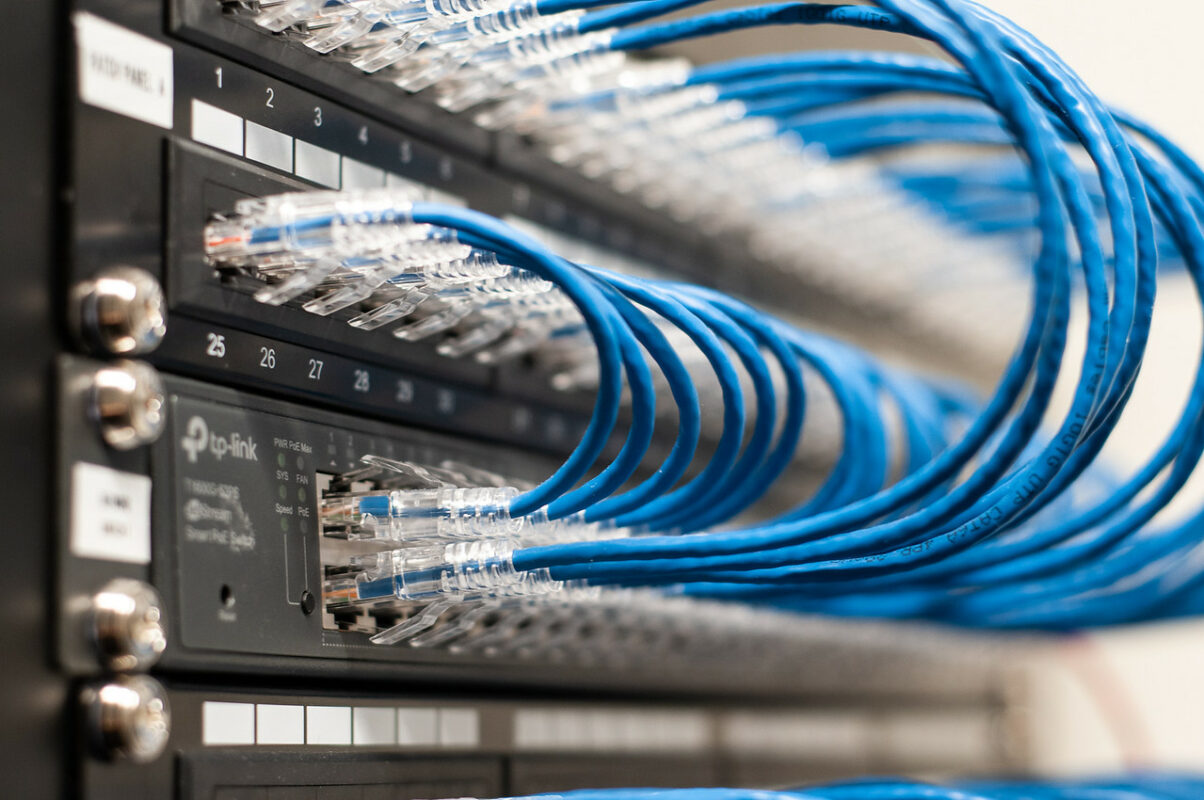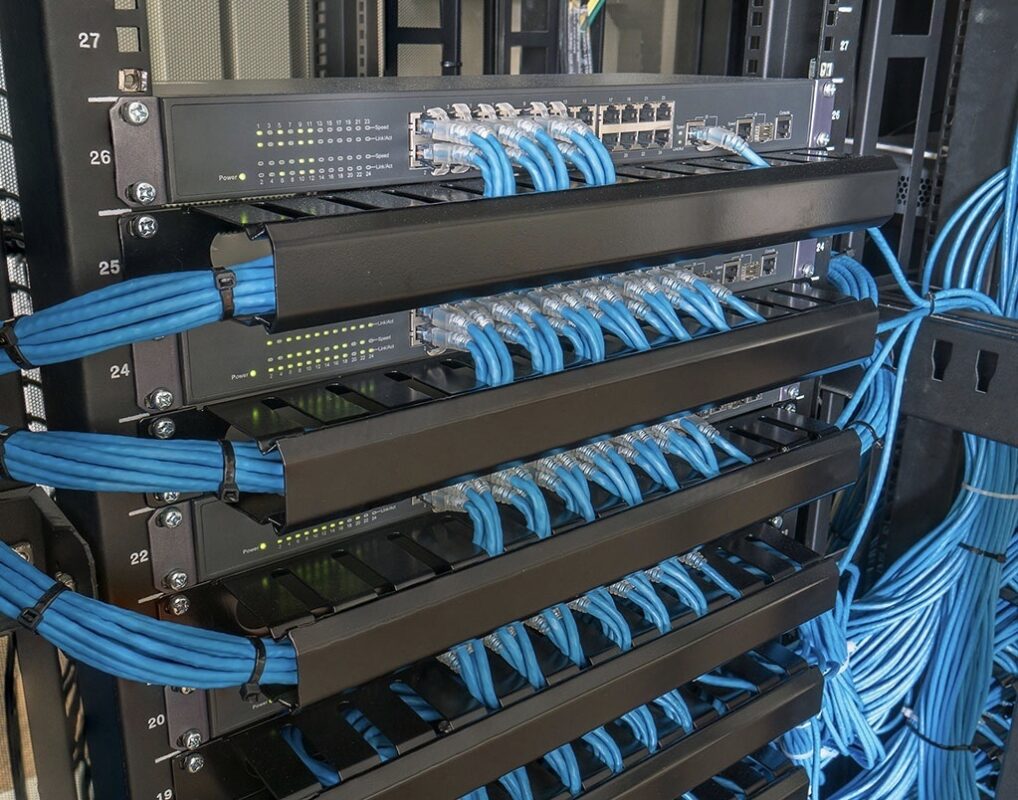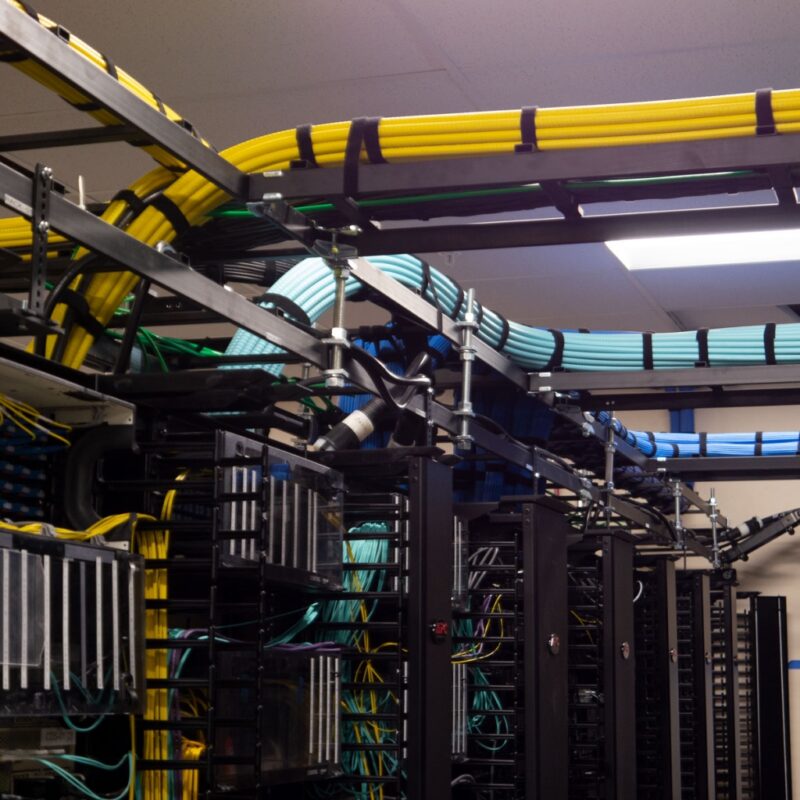STRUCTURED CABLING FOR COMPANIES: HOW TO IMPLEMENT A COMMUNICATION NETWORK READY TO “DIGITIZE EVERYTHING”?
When we talk about structured cabling for companies, we are not referring only to cables, but to complete solutions for data, voice, and image traffic between the various corporate sectors.
Structured cabling is a communication network made up of cables, connectors, and equipment such as routers, switches, and backbones.
Installed according to a project prepared by specialized professionals, this infrastructure allows the unifying, in a single cable infrastructure, all the telecommunication channels of a building.
Therefore, structured cabling for companies allows the traffic of internet and telephony signals. As well as the transmission of images, data, and voice in internal circuits of computers or CCTV, as in environmental monitoring systems and remote management of corporate processes.
To help organize your company’s structured cabling network, let’s explain below:
- What types of cables are most commonly used?
- How is structured cabling designed and executed for companies?
- What are network topologies and which ones can be deployed in the corporate environment?
- Are there standards for structured cabling in companies?
- How is structured cabling maintained?
- What are the advantages of adopting a logical network in your corporation?
To start the structured cabling project in a company, you need to ask the most basic question of all…
What type of cable to use in a structured cabling network?
The cables most used today in corporate data communication networks are metallic pairs and optical fibers.
The metallic cabling is made of copper wrapped in shields against electromagnetic interference. It transmits the data by electrical impulses, while the optical fiber carries out the communication by means of light signals.
The fiber is a thread of glass thinner than a hair, through which the data signals travel by the reflection of light. This transmission mode allows higher speeds and eliminates interference that can affect metallic cables. This increases the quality of communication.
So if a company depends on ultra-speeds, it will likely choose fiber optics. However, the higher cost of fibers can be a deterrent. And in this case, metallic cables remain a safer and more viable option.
Hybrid systems can also be designed providing for the use of both types of structured cabling in different functions and sectors of the corporation.
Both types of structured cabling have advantages and disadvantages. The choice of which one to use depends on the elaboration of a study that considers the communication needs of each company. See the comparison between optical fiber x metallic pair:
The definition of the best type of cable is done according to the budget and data communication needs of each company.
The main requirements considered in this choice are bandwidth and the required speed. In addition to the desired quality for the transmission of information through the company’s structured cabling network.
Designing and installing structured cabling for businesses in 5 steps
The installation of a structured cabling network for companies, residential buildings, or industries depends on the elaboration of a project that includes floor plans, spreadsheets with cost estimates, and a descriptive memorial that prescribes the types of cables and equipment to be used.
In a simplified way, we can summarize these steps of the communication network deployment in five steps.
1. Structured cabling project
At Starlight, the project begins to be defined after a series of meetings between engineers and the customer. Network planning takes into account the type of building, equipment, and amount of data. As well as the nature of the activities carried out in the corporate environment.
Based on the data collection, the type of structured cabling is defined, as well as the layout of the data network, which is dimensioned and represented in several floor plans.
There are several layouts, which are the topologies – the way in which cables and equipment are organized in the corporate communication network.
After defining the layout of the network, the plants are designed: technical drawings that indicate the path of the cables, the positioning of the backbones, routers, and other network equipment.
The floor plans also show the location of the workstations that will use the traffic data and all the details of architectural interference involving the company’s communication network.
2. Descriptive memorandum of the installation of the corporate communication network
After all the definitions are approved in the project, the descriptive memorial is prepared. It is a document where the parameters of the company’s structured cabling network are described, as well as the processes that will be used in its installation.
3. Cost spreadsheet
With the project and memorial approved, it is now possible to prepare a spreadsheet with the estimated costs of the equipment and the work.
Much of the investment will depend on the choice of cables and the topology or “layout” defined for the structured cabling network.
4. Installation of the company’s structured cabling
Now yes, the implementation of the corporate communication network is carried out by qualified labor. And a series of requirements must be taken into account. Between them:
- Installing structured cabling for businesses is a delicate operation, as cables and optical fibers can be easily broken.
- For this reason, cables cannot be “clustered”, as this could generate interference that impairs the quality and speed of data transmission.
- In addition, the work must be clean, as the mere presence of dust can, for example, prevent the passage of light in an optical fiber. This is because the fiber is nothing more than a strand of glass, through which data travels in the form of light signals.
- In some works, adaptations are necessary for the architectural infrastructure of the building. A logical network often requires a recessed ceiling or raised floor, under which cables and equipment are installed.
- Walls can be broken, as well as installed with drywall, for example.
- In addition, excavations may be necessary for connecting internet links.
- And structured cabling, in other cases, can be built-in, requiring architectural interference and finishing works.
That’s why it’s important to have a company capable of dealing with structured cabling, with civil and electrical works at the same time. This is a concept that we can call “multi-service engineering”, in which Starlight is specialized.
5. As built
After installing the structured cabling, it is very important to carry out the “as-built project”, a plan that shows exactly how the work turned out after completion.
The as-built is a “hand off the wheel” when carrying out renovations and layout changes in the corporate environment. This is very relevant today, due to the speed with which new technologies are developed and assimilated, causing more frequent changes in communication networks.
In addition, the as-built is essential to facilitate the maintenance of the structured cabling network, which we will see in more detail below.
Don’t forget structured cabling maintenance!
Currently, structured cabling in companies connects the various corporate sectors with telephony, internet, and other data network providers.
This connection is often crucial for employees and customers to access administrative software and systems.
Therefore, if the cables and equipment of this communication network present points of failure, they can generate disorders such as:
- Loss of signal quality
- Interferences in communication
- Faults or interruptions in data transmission
- Unavailability of internet access, information, and administrative systems
- Downtime of administrative services that rely on online data processing
- Loss of productivity, drop in business and profits
- Interruption of internal TV and voice circuits that affect the monitoring, internal communication, and security of companies.
- The quality decline in services provided to consumers due to data transmission losses.
Preventive maintenance, performed periodically, can identify these problems before they occur. The routine of a structured cabling maintenance plan for companies can be customized, containing, for example:
- Diagnosis of cables and network equipment pointing out effective solutions for disturbances and problems encountered.
- Testing or certification of points and cables, when necessary.
- Presentation of certification report of data usage points.
- Changes or rearrangement of points.
- Technical support and evaluation of electrical installation and structured cabling.
Attention to structured cabling standards for companies!
A company’s logical network must follow standards defined by standards such as EIA/TIA-568, which establishes the criteria for installing and planning structured cabling.
The standard defines, for example:
- The telecommunications cabling specifications for corporate offices.
- The topology and distances must be followed when installing structured cabling.
- Performance parameters in data transmission.
- Types of connectors and pins that should be used.
These regulatory requirements are used to ensure that the useful life of structured cabling in enterprises is at least 10 years.
Other structured cabling standards
In addition to EIA/TIA-568, standards such as ABNT NBR 14565 are also used, which guides the projects and installation of structured cabling for companies in commercial buildings and Data Centers, as well as standard 569, ISO 11801, ANSI 606, the IEEE and the TIA-569.
According to EIA/TIA-569, a data communication network must have six structured cabling subsystems, which are:
- Building Entrance: connection place between external cabling and internal backbone cabling of the building.
- Equipment Room: the room where the most complex equipment of the network is located.
- Backbone Cabling: Backbone cabling is responsible for the interconnection between the telecommunications closets, equipment rooms and entrance facilities.
- Telecommunications Cabinet: area inside the building that houses the equipment of the telecommunications cabling system, such as mechanical terminations and cross-connects.
- Horizontal Cabling: This is the part of the structured cabling system that runs from the telecommunications outlet of the work area to the telecommunications closet.
- Workspace: This subsystem of structured cabling corresponds to the workspace. It goes from the telecommunications outlet to the company’s computers or workstation equipment.
Standards must be followed when designing, installing, and maintaining cabling. They specify minimum parameters of cables, distances, connectors, and other equipment in each subsystem, to guarantee the durability, efficiency, and quality of data communication in structured cabling networks for companies.
Why deploy a structured cabling network in your company?
With technological advances in recent years, structured cabling network systems have become as complex as they are essential.
The reason is that we live in a process of hyperconnectivity that requires communication processes that are increasingly convergent, fast, and voluminous.
Today, companies depend on structured cabling networks that support an enormous amount of data, voice, and image in their own circuits with the necessary infrastructure to easily operate them in the day-to-day of corporations.
Thus, modern structured cabling solutions were created for companies. And with that, cables and network equipment – such as switches, routers, and backbones – have been upgraded to the pace of “automating everything”.
Benefits of structured cabling
The objective of installing a modern logical network is to support internet and telephony systems to transmit information, images, and voice with high quality and speed.
More than that, they must be connected in an organized and well-distributed way, allowing the entire logical network of the company to be unified and to work in a simple and efficient way.
For this to happen, it is necessary to have a well-designed and complete structure of structured cabling within the corporation.
These networks, when planned according to the needs of each business, generate savings in money and time.
This is because they increase the manageability of corporate networks.
Therefore, they are vital for companies looking to increase lifespan. In addition to the quality and versatility of its data traffic systems.
Connection with the future
Anyone who has been working in the IT area for a long time must remember that, a few decades ago, company information was stored in various sectors.
They were rarely grouped in one place. There were several machines and hundreds of cables scattered around the offices.
The fact is that it was enough for a cable to be damaged, a computer to fail, and all the company’s data was at risk of being lost.
The stress was great. A failure like this in the system compromises the entire productivity of the corporation. This is because, in addition to the risk of losing files, there is the fact that work can be paralyzed.
With this simple example, you can understand how important an enterprise-structured cabling system is.
The technical solution is the basis for a modern communication network and cabling system.
The standardization of structured cabling for companies allows flexibility when installing the system, independence of protocols and suppliers, in addition, to ease of managing the entire installed structure.
In this way, the implementation of a structured cabling network within the company brings about a restructuring of the network system and a relocation of personnel.
All this is in order to improve the use of the entire corporate process. In this way, the company will be aligned with the keyword of the future: hyper-automation or “digitalization of everything”. Ready to get started?
Starlight specializes in structured cabling for companies
Throughout this post, we show that structured cabling for companies is a fundamental piece when it comes to security. As well as it is also fundamental for speed and quality in data traffic.
Having an agile, secure, and efficient system guarantees greater efficiency in the processing of corporate information.
Therefore, it is essential to have an engineering company specialized in the installation of structured cabling for companies.
And in this, Starlight stands out in the market. There are 30 years of experience and technical improvement to offer the best in the market to its customers.
This is done with frequent training of personnel in compliance with the rules that govern the installation of structured cabling networks for companies.
With this, the customer is sure to hire a high-quality service, prepared to support the data, electrical and civil aspects without generating installation problems that cause headaches in the medium and long term.












